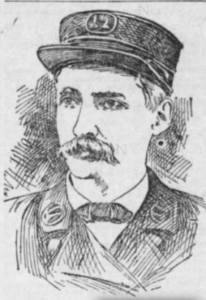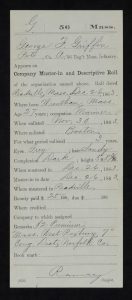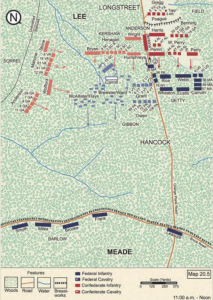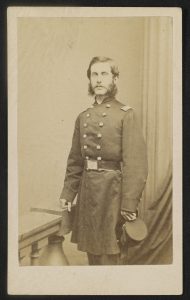Fighting Rebels and Fighting Fires: The Life of George F. Griffin (Part 1/2)
Sometime around midnight of April 19, 1880, a defective range stove started a fire on the first floor of No. 18, Travers Street, in Boston, Massachusetts. A passing patrolman in the police department saw the flames and raced to a fire alarm box. When the patrolman pulled a lever, the box sent a telegraphic signal to a number of fire stations in the area. Within minutes a crashing and clanging of bells announced the arrival of numerous fire engines that stopped in front of the blaze.[1]

By the time the firefighters got to the scene, the fire had jumped to nearby structures, lighting up the night sky. Among those arriving was George F. Griffin, who jumped off his apparatus Hook & Ladder Co. 8, secured his red captain’s helmet, and made his way into one of the burning homes. It was not the first time Griffin had put himself in harm’s way, though. George Griffin had in fact already survived the Civil War, and been a member of the Boston Fire Department now close to twelve years. He was a man who devoted his entire life in the service of others, and for something larger than himself. This is his story.
Gorham, New Hampshire makes up part of southern Coös County, just a couple of towns over from the Maine border. Griffin was born there on April 18, 1838, the second-born son of John and Cynthia Griffin. The whole family, which eventually included twelve children including George, relocated to Milbridge, Maine when he was a young boy.[2] Milbridge, located northeast of Maine’s famous Bar Harbor, is similarly right on the Atlantic Coast. Lumber was floated down the Narraguagus River to Milbridge, where it could be shipped out from any one of the many shipyards. The town’s maritime trade presented a plethora of job opportunities, and by the age of twelve, George had become a sailor. Ten years later he was still doing the same work– the 1860 Census lists both he and one of his younger brothers, Benjamin, “Seaman.”[3]
War’s outbreak saw the Griffin family mobilize for the Union. George’s younger brother Alcander Griffin enlisted in the 13th Maine. Deployed to Louisiana, the 13th Maine garrisoned the recently-captured Fort St. Philip outside of New Orleans through the summer of 1862. It was there that the twenty-one year old Alcander died of disease.[4]
George and another of his brothers, Thaddeus, took their opportunity to join the Union war effort in December, 1863. The duo ended up enlisting in Company A, 56th Massachusetts Infantry. They both received a $25 bounty for their enlistments. George was twenty-five, and his muster record notes he had gray eyes, sandy hair, a dark complexion, and stood 5’8”.[5]

The 56th Massachusetts spent the winter of 1863-64 training in Massachusetts before transferring to Annapolis, Maryland in the spring. There they joined the rest of the First Division, Ninth Corps, and began the long march to meet up with the rest of the Army of the Potomac. George and his brother’s first experience in combat would be the opening shots of the blood-soaked Overland Campaign.
Warfare was a distant concept for George Griffin until May 6, 1864. He had already lost one brother, Alcander, to that war, but had never seen its effects firsthand. Having marched across the Rapidan River, the 56th Massachusetts caught up with the Army of the Potomac as the battle of the Wilderness raged into its second day.
The 56th Massachusetts advanced through the dense confines of the Wilderness. It was dark and foreboding; years of cutting had reduced the area to massed entanglement of second- and third-generation regrowth. They could hear the firing, but could not make heads or tails of where it was coming from. Company F’s Captain Z.B. Adams wrote, “The whistling and shrieking and pinging of the balls, which went on unceasingly until evening, heard by some of our soldiers for the first time, made them bow their heads or get down behind their cover.”[6]
George Griffin left no accounts or reminiscences of his wartime experiences. But we know he was about to find himself in the middle of some of the heaviest fighting of the entire war. The day before, both sides had thrown themselves into one another around the Orange Plank Road-Brock Road intersection. Federal forces needed to keep the intersection open to allow for the quick movement of manpower and supplies. If Confederates could seize the road, they on the other hand could disrupt the entire Federal spring offensive before it even got a chance to get off the ground. Now on May 6 the fighting resumed, with both armies continuing to shed blood contesting the ground.
Far off to the left, four Confederate brigades were maneuvering along the unfinished railroad to get on the Federals’ flank. In the afternoon those brigades slammed into Winfield Hancock’s Second Corps, sending the soldiers reeling in confusion. At the same time Lt. Gen. James Longstreet directed other elements of his corps to attack down the Orange Plank Road, headed straight in the direction of where the 56th Massachusetts struggled through the woods.

(Copyright Bradley Gottfried)
A tremendous cacophony roared as thousands of soldiers struggled against one another along the Plank Road-Brock Road intersection. “The woods seemed to be full of smoke, and shots came in almost every direction except from behind us,” Capt. Adams recollected.[7]
To try and stem the tide of the Confederate flank attack, the 56th peeled off the main line and rushed towards the Confederates. “A heavy fire was immediately opened on us, and as some of the men were in confusion from some of the Second Corps running through them, Colonel Griswold ordered the colors forward,” another of the 56th’s officers, Stephen Weld, recalled. Charles Griswold was shot through the neck and died soon after.[8]
The Confederate fire proved too much, and the 56th Massachusetts fell back in confusion towards the famed Plank Road-Brock Road Intersection. There were Second and Ninth Corps units all jumbled together from the day’s confused fighting, but those soldiers banded together to pitch in and try and repel Longstreet’s advance.
“Trees were cut down by the bullets, and bark was knocked into my face time and again by the bullets,” Weld wrote.[9] And in the midst of all that fighting were George and his brother Thaddeus. Sometime during the fighting, though it is not clear when, Thaddeus Griffin was shot. He lingered until either May 17 or May 22 (the records are contradictory), before dying. The war had killed another of George’s brothers. In just a couple of brief hours George Griffin had learned what war meant.[10]

George, though, was unhurt. He survived the bloodletting around the intersection, and he helped stymie the Confederate attack. He marched with the army to Spotsylvania, and fought in the trenches and mud for the next two weeks before once again resuming the march. George’s service record indicates he was in fact everywhere the 56th Massachusetts fought. He was at Cold Harbor, and he attacked Petersburg’s outer defenses in mid-June. He would have participated and seen the infamous fighting at the Crater on July 30, 1864. Peeble’s Farm, Fort Stedman, and the last of the attacks against Petersburg on April 2, 1865, before the ultimate march to Appomattox. George Griffin was there, and saw all the horrors that warfare offered. By the end of the war, he was one of Company A’s corporals.
The 56th Massachusetts returned to Boston in July, 1865. They mustered out of service having seen nearly 120 of its number, including Thaddeus Griffin, killed or mortally wounded in action. The war was over, and George Griffin, all of twenty-seven years old, was left to ask: Now what?
______________________________________________________________
[1] Documents of the City of Boston for the Year 1880, Vol. 2, City Document. 58, 200.
[2] Arthur W. Bailey, A Complete History of Boston Fire Department, Vol. 2 (Boston: John P. Dale & Co., 1889), 444; 1850 United States Census.
[3] Bailey, 444; 1860 Census.
[4] Edwin B. Lufkin, History of the Thirteenth Maine Regiment From its Organization in 1861 to Its Muster-Out in 1865 (Bridgton: H.A. Shorey, 1898), 53.
[5] George Griffin Compiled Service Record.
[6] Z.B. Adams, “In the Wilderness,” in Civil War Papers Read Before the Commandery of the State of Massachusetts, Military Order of the Loyal Legion of the United States, Vol. 2 (Boston: Military Commandery of the State of Massachusetts, 1900), 377.
[7] Ibid., 379.
[8] Stephen M. Weld, War Diary and Letters of Stephen Minot Weld, 1861-1865 (Cambridge: Privately Published, 1912), 286.
[9] Ibid., 287.
[10] Thaddeus Griffin Compiled Service Record.
Splendid! Thanks! I have always been curious about Firefighters of the 1830-1880 era.
Thanks so much for reading and the comment!